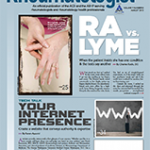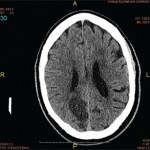NEW YORK (Reuters Health)—Patients with vitiligo commonly have other autoimmune diseases, according to a cross-sectional study. “Vitiligo is a systemic disease with multiple comorbidities,” Dr. Iltefat Hamzavi from Henry Ford Hospital in Detroit, Mich., told Reuters Health by email. “The number of patients with neurologic diseases and inflammatory disease was much higher than we anticipated.”…

Diagnostic Clues, Tips Useful for Differentiating RA and Lyme Disease
RA vs. Lyme I am writing to comment on your interesting and useful article that appeared on the front page of the August issue of The Rheumatologist, “RA vs. Lyme,” by Charles Radis, DO. Arriving at a definite diagnosis of active RA early on is often not an easy task. The author of this article…

New Gout Criteria from the ACR/EULAR Focus on Clinical Trials, Global Standards
Gout affects nearly 4% of American adults, causing joint inflammation, pain and crystal deposits that may lead to bone erosion over time. At least five different classification criteria for gout are used worldwide, creating potential discrepancies in clinical trial enrollment and eventual results. An international panel of investigators collaborated to create new, standardized gout classification…
Rheumatology Coding Corner Answer: Proper Coding for Post-Traumatic Osteoarthritis
CPT: 99213, 73500-RT, 73500-LT ICD-10: M16.52 This E/M service entailed: The history is detailed; The examination is expanded problem focused; and The medical decision making is of low complexity. The X-ray reviewed was for radiologic examination, hip, unilateral: one view for the left hip and for the right hip. M16.52—The diagnosis identifies unilateral post-traumatic osteoarthritis…
Rheumatology Coding Corner Question: Coding for Post-Traumatic Osteoarthritis
Post-Traumatic OA A 70-year-old female patient comes in for a follow-up visit for pain and stiffness in her left hip. She injured her hip in a skiing accident three years before and reports the X-rays at that time showed no fractures. Due to no obvious fracture at the time, she was given ibuprofen and advised…

Sjögrens Syndrome: The Need to Bridge Patient Symptoms & Objective Findings
Despite a generation of advances in molecular biology, a huge gap exists between the Sjögren’s syndrome (SS) patient’s description of their symptoms and the objective findings. Current issues include: Many SS patients are misclassified as either rheumatoid arthritis (RA) or systemic lupus erythematosus (SLE), even within rheumatology clinics. Frequently, the sickest SS patients with extraglandular…
Bronchial Tissue Immune Activation Seen in Early Rheumatoid Arthritis
NEW YORK (Reuters Health)—Patients with untreated early rheumatoid arthritis (RA) show signs of immune activation and local inflammation in their bronchial tissues, researchers from Sweden report. Previous studies have shown that patients with RA have shared citrullinated epitopes in the lungs and joints, as well as anticitrullinated protein antibodies (ACPA) in bronchoalveolar lavage (BAL), suggesting…

Does Methotrexate Increase Skin Cancer Risk?
A recent study connects the use of immunosuppressant and biologic agents to an increased risk of nonmelanoma skin cancer in patients being treated for RA and IBD…

Improve RA Care with Vitamin D
Background Autoimmune diseases, such as rheumatoid arthritis (RA) and systemic lupus erythematous, occur when the body attacks its own tissue because it cannot differentiate between self and non-self. This is mainly through deregulation of the immune system. Vitamin D has been known to play a critical role in bone mineralization and bone health. Activated vitamin…

Rheumatology Case Report: When Moyamoya Disease Mimicks Primary Central Nervous System Vasculitis
Case report: A 60-year-old Hispanic male with poorly controlled hypertension was sent from the primary care clinic for evaluation of malignant hypertension with a systolic blood pressure above 200 mmHg. His symptoms at the time of presentation included episodic confusion, worsening vision and an unsteady gait. A head computed tomography (CT) scan showed a subacute…
- « Previous Page
- 1
- …
- 248
- 249
- 250
- 251
- 252
- …
- 351
- Next Page »